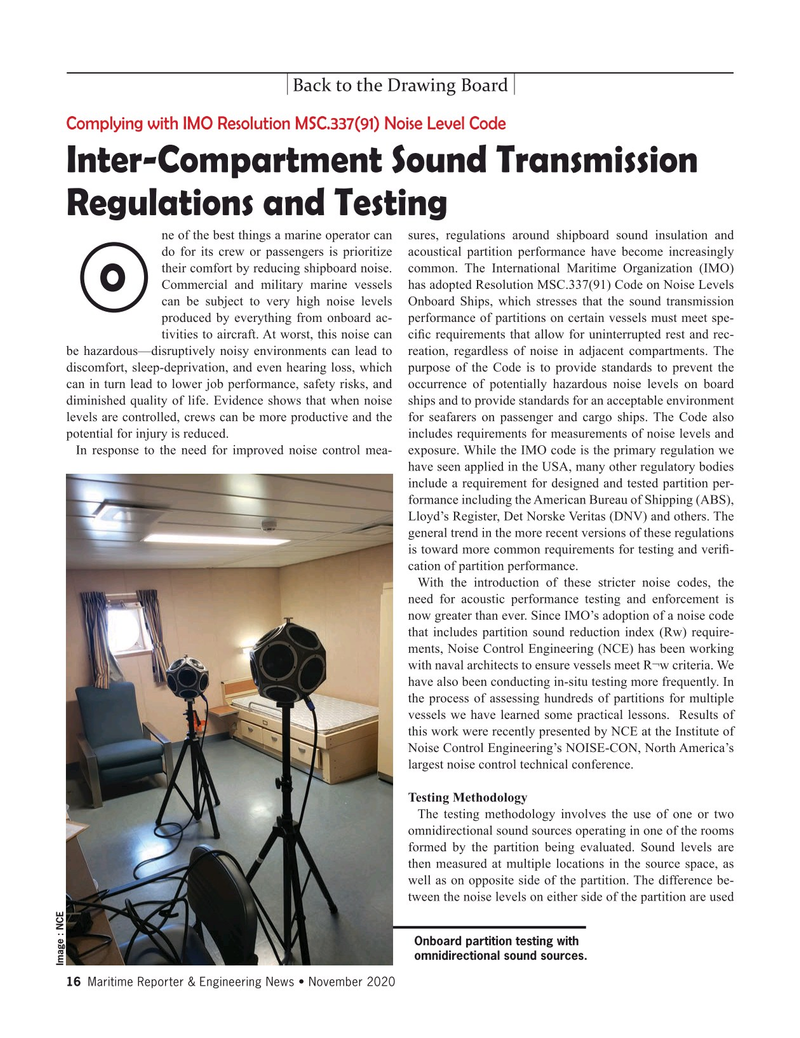
Page 16: of Maritime Reporter Magazine (November 2020)
Workboat Edition
Read this page in Pdf, Flash or Html5 edition of November 2020 Maritime Reporter Magazine
Back to the Drawing Board
Complying with IMO Resolution MSC.337(91) Noise Level Code
Inter-Compartment Sound Transmission
Regulations and Testing ne of the best things a marine operator can sures, regulations around shipboard sound insulation and do for its crew or passengers is prioritize acoustical partition performance have become increasingly their comfort by reducing shipboard noise. common. The International Maritime Organization (IMO)
Commercial and military marine vessels has adopted Resolution MSC.337(91) Code on Noise Levels
O can be subject to very high noise levels Onboard Ships, which stresses that the sound transmission produced by everything from onboard ac- performance of partitions on certain vessels must meet spe- tivities to aircraft. At worst, this noise can ci? c requirements that allow for uninterrupted rest and rec- be hazardous—disruptively noisy environments can lead to reation, regardless of noise in adjacent compartments. The discomfort, sleep-deprivation, and even hearing loss, which purpose of the Code is to provide standards to prevent the can in turn lead to lower job performance, safety risks, and occurrence of potentially hazardous noise levels on board diminished quality of life. Evidence shows that when noise ships and to provide standards for an acceptable environment levels are controlled, crews can be more productive and the for seafarers on passenger and cargo ships. The Code also potential for injury is reduced. includes requirements for measurements of noise levels and
In response to the need for improved noise control mea- exposure. While the IMO code is the primary regulation we have seen applied in the USA, many other regulatory bodies include a requirement for designed and tested partition per- formance including the American Bureau of Shipping (ABS),
Lloyd’s Register, Det Norske Veritas (DNV) and others. The general trend in the more recent versions of these regulations is toward more common requirements for testing and veri? - cation of partition performance.
With the introduction of these stricter noise codes, the need for acoustic performance testing and enforcement is now greater than ever. Since IMO’s adoption of a noise code that includes partition sound reduction index (Rw) require- ments, Noise Control Engineering (NCE) has been working with naval architects to ensure vessels meet R¬w criteria. We have also been conducting in-situ testing more frequently. In the process of assessing hundreds of partitions for multiple vessels we have learned some practical lessons. Results of this work were recently presented by NCE at the Institute of
Noise Control Engineering’s NOISE-CON, North America’s largest noise control technical conference.
Testing Methodology
The testing methodology involves the use of one or two omnidirectional sound sources operating in one of the rooms formed by the partition being evaluated. Sound levels are then measured at multiple locations in the source space, as well as on opposite side of the partition. The difference be- tween the noise levels on either side of the partition are used
Onboard partition testing with omnidirectional sound sources.
Image : NCE 16 Maritime Reporter & Engineering News • November 2020
MR #11 (1-17).indd 16 11/9/2020 8:46:00 AM

 15
15

 17
17
